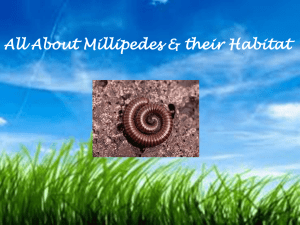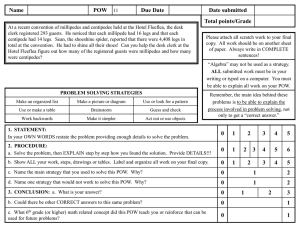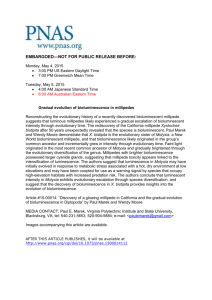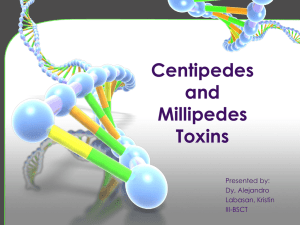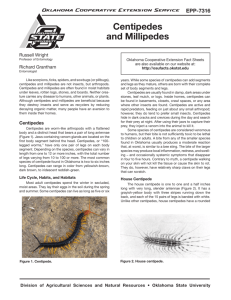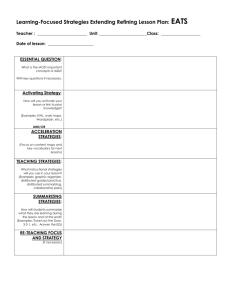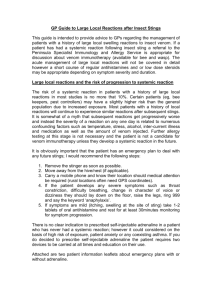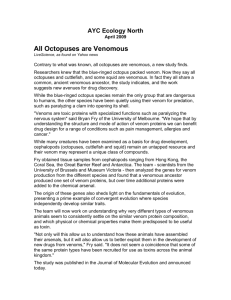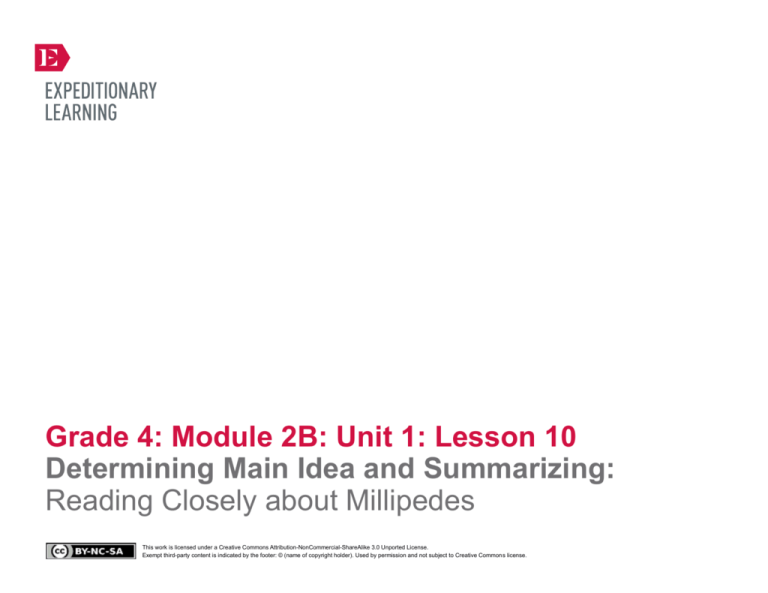
Grade 4: Module 2B: Unit 1: Lesson 10
Determining Main Idea and Summarizing:
Reading Closely about Millipedes
This work is licensed under a Creative Commons Attribution-NonCommercial-ShareAlike 3.0 Unported License.
Exempt third-party content is indicated by the footer: © (name of copyright holder). Used by permission and not subject to Creative Commons license.
GRADE 4: MODULE 2B: UNIT 1: LESSON 10
Determining Main Idea and Summarizing
Reading Closely about Millipedes
Long-Term Targets Addressed (Based on NYSP12 ELA CCLS)
I can paraphrase portions of a text that is read aloud to me. (SL.4.2)
I can determine the main idea using specific details from the text. (RI.4.2)
I can summarize informational text. (RI.4.2)
Supporting Learning Targets
Ongoing Assessment
• I can determine the main idea of a section of Venom.
• Listening Closely note-catcher (page 14 of Animal
Defenses Research Journal)
• I can summarize a section of Venom using the main idea and supporting details found in the text.
• Determining the Main Idea note-catcher (page 15 of
Animal Defenses Research Journal)
Copyright © 2013 by Expeditionary Learning, New York, NY. All Rights Reserved.
NYS Common Core ELA Curriculum • G4:M2B:U1:L10 • June 2014 •
1
GRADE 4: MODULE 2B: UNIT 1: LESSON 10
Determining Main Idea and Summarizing
Reading Closely about Millipedes
Agenda
Teaching Notes
Opening
• This lesson marks a transition in Unit 1 from a general overview of animal defense mechanisms to a
deeper study of millipede defense mechanisms. This study of the millipede is designed to be a model of
what students will later do when researching in their animal expert groups.
A. Reviewing Learning Targets (5 minutes)
B. Engaging the Reader: Read-aloud of Venom (10
minutes)
Work Time
A. Reading an Informational Text: Determining the
Main Idea and Identifying Supporting Details (20
minutes)
B. Guided Practice: Writing a Summary (15 minutes)
Closing and Assessment
A. Exit Ticket: KWL: Millipede Defense Mechanisms
(10 minutes)
• The opening of this lesson is slightly different from prior lessons. Students begin by reviewing the
learning targets instead of with an “engaging the reader” activity. This brings awareness to students
about the shift in their focus of study from general defense mechanisms to those of the millipede.
• The Determining the Main Idea note-catcher supplied in the supporting materials of this lesson has an
intentional strike-through of the first bullet point. You may wish to use this detail to model choosing
details that are from the text but don’t directly support the main idea.
• This lesson builds on previous lessons focused on determining the main idea by teaching students to
write a summary of the text. In this lesson, the summary is written with students. Students practice
summarizing again in Lesson 12, and are assessed on this skill in the End of Unit 1 Assessment in
Lesson 14. They continue to practice summarizing in Unit 2.
Homework
A. Continue your independent reading.
Copyright © 2013 by Expeditionary Learning, New York, NY. All Rights Reserved.
NYS Common Core ELA Curriculum • G4:M2B:U1:L10 • June 2014 •
2
GRADE 4: MODULE 2B: UNIT 1: LESSON 10
Determining Main Idea and Summarizing
Reading Closely about Millipedes
Lesson Vocabulary
Materials
summarize, index, source;
exoskeleton , toxin , ooze (15)
• Equity sticks
• Document camera
• Venom (book for teacher read-aloud, page 15)
• Listening Closely note-catcher (page 14 of Animal Defenses research journal; one per student and one to display)
• Listening Closely note-catcher (completed, for teacher reference)
• Animal Defenses research journals (from Lesson 1; one per student)
• Copy of Page 15 of Venom, “They Have Legs and They Know How to Use Them” (one per student)
• Determining the Main Idea note-catcher (page 15 of Animal Defenses research journal; one per student and one to display)
• Determining the Main Idea note-catcher (completed, for teacher reference)
• Summarizing Informational Text anchor chart (new; co-created with students during Work Time Part B)
• Millipede Defense Mechanisms: KWL chart (page 13 Animal Research Journal; from Lesson 9; one per student))
Copyright © 2013 by Expeditionary Learning, New York, NY. All Rights Reserved.
NYS Common Core ELA Curriculum • G4:M2B:U1:L10 • June 2014 •
3
GRADE 4: MODULE 2B: UNIT 1: LESSON 10
Determining Main Idea and Summarizing
Reading Closely about Millipedes
Opening
Meeting Students’ Needs
A. Reviewing Learning Targets (5 minutes)
• Remind students that they have completed the first go-through of the Animal Defenses research journal, researching and
collecting information about general animal defense mechanisms. They now will continue learning about animal defense
mechanisms and research the millipede. Explain that the process will be the same—they will listen to texts about the
millipede, read and reread for main idea and vocabulary. Tell students this work is leading up to their own research of
different animals in expert groups to prepare for the final performance task.
• Discussing and clarifying the
language of learning targets helps
build academic vocabulary.
• Use equity sticks to call on students to read the learning targets:
* “I can determine the main idea of a section of Venom.”
* “I can summarize a section of Venom using the main idea and supporting details found in the text.”
• Remind students that the first and third targets should be familiar to them. Focus on the second target by circling the word
summarize and asking:
* “What does it mean to summarize?”
• Listen for responses like: “It’s when you tell the big ideas of a text.” Clarify as needed. Explain to students that they will be
using their understanding of how to determine the main idea and identify supporting details to summarize a text about
millipedes.
Copyright © 2013 by Expeditionary Learning, New York, NY. All Rights Reserved.
NYS Common Core ELA Curriculum • G4:M2B:U1:L10 • June 2014 •
4
GRADE 4: MODULE 2B: UNIT 1: LESSON 10
Determining Main Idea and Summarizing
Reading Closely about Millipedes
Meeting Students’ Needs
Opening (continued)
B. Engaging the Reader: Read-aloud of Venom (10 minutes)
• Using a document camera, display the cover of Venom so all students can see. Open to pages 74 and 75 and ask:
* “What did we learn about animal defense mechanisms when we last read aloud from Venom?”
• Listen for responses like: “Bees use stingers to protect themselves.” Validate responses and explain to students that they will
be listening to another section of Venom today. Tell students they will then use this text to determine the main idea and
summarize later in the lesson.
• Inform students that they will start their study of the millipede and its defense mechanisms. Model using the index in
Venom to find information about the millipede. Point out that the index is in the back of the book, is organized
alphabetically, and that the numbers indicate the page number with information about the topic it is next to. Also point out
the distinction between “millipede” and “yellow spotted millipede”—note for students that in this case, there is a specific
kind of millipede that is mentioned in this book in addition to general information about millipedes. This is important to
note for students because when they study their expert group animals, some groups will be studying specific kinds of
butterflies, octopuses, or armadillos, so they will need to recognize the distinction between the general animal group and the
specific species in the index.
• Display the blank Listening Closely note-catcher and invite students to open to the next one on page 14 in their Animal
Defenses research journals. Ask:
* “How do we use this graphic organizer to help us understand a text read aloud?”
• Use equity sticks to call on students. Listen for responses like: “We record the animal protects itself in the left column and
explain how that helps the animal survive in the right column. We write a gist statement at the bottom.”
• Remind students that they will listen to a new part of Venom read aloud several times. Remind them that the first time they
hear it read aloud, they should simply listen to what is being read. The second time, they should begin to fill in the table.
• Read aloud page 15 as students read along.
• Invite students to turn and talk with a neighbor, sharing one interesting thing they heard during the read-aloud. Use equity
sticks to call on two students to share what their partners found interesting.
• Tell students that they will now hear page 15 read aloud a second time and should now record notes in the note-catcher as
you read aloud.
Copyright © 2013 by Expeditionary Learning, New York, NY. All Rights Reserved.
NYS Common Core ELA Curriculum • G4:M2B:U1:L10 • June 2014 •
5
GRADE 4: MODULE 2B: UNIT 1: LESSON 10
Determining Main Idea and Summarizing
Reading Closely about Millipedes
Meeting Students’ Needs
Opening (continued)
• Read aloud page 15 in Venom again, stopping briefly after each paragraph. If necessary during each short pause, remind
students to fill in notes on their note-catchers.
• Invite students to turn and talk with a partner. Ask:
* “What is an example of how millipedes protect themselves?” Listen for responses like: “Millipedes roll into tight balls.”
* “How do those defense mechanisms help millipedes survive?” Listen for responses like: “Their exoskeleton makes it hard
to hurt the millipede’s body when it’s curled into a ball.”
* “What was the gist of this text?” Listen for responses like: “The main message of this text was how centipedes and
millipedes protect themselves. Some are harmless and some are poisonous.”
• Point to the question below the table on the graphic organizer—“What is the gist of this section of Venom?” Invite students
to jot down the gist of this part of the text on these lines. If necessary, prompt students by asking: “What is your initial sense
of what this part of the text was mostly about?”
• Remind students they will have many more opportunities to read this book, and can read through it on their own during
independent reading or in their free time during the school day if they wish.
Copyright © 2013 by Expeditionary Learning, New York, NY. All Rights Reserved.
NYS Common Core ELA Curriculum • G4:M2B:U1:L10 • June 2014 •
6
GRADE 4: MODULE 2B: UNIT 1: LESSON 10
Determining Main Idea and Summarizing
Reading Closely about Millipedes
Work Time
Meeting Students’ Needs
A. Reading an Informational Text: Determining the Main Idea and Identifying Supporting Details (20
minutes)
• The teacher may offer selected
shorter passages to specific groups
based on the readiness and needs of
the group. This provides an
opportunity for students to read a
complex text within the fourthgrade level span, but differentiates
the length of the text, not the
complexity.
• Distribute a copy of page 15 of Venom, “They Have Legs and They Know How to Use Them” to each student.
• Invite students to turn to page 15 of their research journals to the Determining the Main Idea note-catcher. Explain
that they will now have a chance to work closely with the text they just listened to, to determine the main idea and find
details that support the main idea of that page.
• Point out the “Source” box in the upper right-hand corner. Explain that whenever they are researching, they should record
the source, or where the information is coming from, in their notes. Ask:
* “What is the source we are using in this lesson? Where is our information coming from?”
• Listen for students to respond with: “Venom.” Prompt them to include the page number and author, and invite them to write
it in the “Source” box on the note-catcher.
• Review determining the main idea by asking:
* “How do we determine the main idea of a section of text?”
• Listen for students describing the process introduced in Lesson 3, saying things like: “We read the text paragraph by
paragraph, and after each paragraph ask ourselves, ‘What is this text about?’ We revise our thinking about the main idea as
we read.”
• Review identifying supporting details by asking:
* “How do we identify details that support the main idea of a section of the text?”
• Listen for students describing the process discussed in Lesson 4, saying something like: “We reread the text paragraph by
paragraph, thinking about the main idea and looking for facts or details that the author used to explain that idea.”
• Invite students to Think-Pair-Share and reread page 15 of Venom independently to determine the main idea of that page.
Tell them to write the main idea in the appropriate box on their note-catcher.
• Once students have shared out whole group, invite students to Think-Pair-Share and reread page 15 of Venom
independently to identify details that support the main idea. Tell them to write at least three supporting details in the
appropriate box on their note-catcher.
Copyright © 2013 by Expeditionary Learning, New York, NY. All Rights Reserved.
• Graphic organizers and recording
forms engage students more actively
and provide the necessary
scaffolding that is especially critical
for learners with lower levels of
language proficiency and/or
learning. For students needing
additional support, provide a
partially filled-in graphic organizer.
• Provide ELLs with a sentence
starter or frame to aid in language
production. For example: One idea
that is repeated again and again
is … or A detail that supports the
main idea of our section is …
• Some students may benefit from
having key sections pre-highlighted
in their texts. This will help them
focus on small sections rather than
scanning the whole text for answers.
NYS Common Core ELA Curriculum • G4:M2B:U1:L10 • June 2014 •
7
GRADE 4: MODULE 2B: UNIT 1: LESSON 10
Determining Main Idea and Summarizing
Reading Closely about Millipedes
Meeting Students’ Needs
Work Time (continued)
• If necessary, model finding a detail that does not support the main idea by saying something like: “Here’s a detail about
millipedes from Venom: (point to this sentence in the third paragraph on page 15 and write it on the note-catcher)
‘Millipedes, relatives of the centipedes, have 20 to 100 body segments, most with two pairs of legs each.’ That detail is
about millipedes. Does it support the main idea of this page, though? The main idea is that centipedes and millipedes
have many defense mechanisms. This detail is about what the millipede looks like, and not its defense mechanisms.
So, I’m going to cross this out because, though it’s a detail, it’s not a detail that supports the main idea.”
B. Guided Practice: Writing a Summary (15 minutes)
• Explain to students that they will use their notes on the main idea and supporting details to write a short summary of page
15 of Venom.
• Invite students to Think-Pair-Share to discuss the following:
* “What is a summary?”
* “How might a summary be different from identifying the main idea or writing a gist statement?”
• Listen for responses like: “A summary tells the main points of a text,” “A summary is a longer than saying the main idea or a
gist statement,” or “A summary includes the main idea and adds on a little bit more to it.”
• Ask students to quickly turn and talk about the summary writing they have already practiced this year. (Listen for them to
remember the paragraphs they wrote from their research notes during Module 1 about the Iroquois.) Remind them as
needed.
• On chart paper, begin a new Summarizing Informational Text anchor chart. Write the word summary on the chart
and a simple definition such as “when you tell the main points of a text.” Tell students that writing a summary will help them
to better understand the text they are reading.
• Invite students to look at the second page of their Determining the Main Idea note-catchers. Point out Reading and Writing
Like a Researcher section. Have students read the prompt. Tell them that a good summary of text usually includes the main
idea of the text and details that support the main idea. Add the following to the anchor chart in bullet points:
– What big idea is explained in this text?
– What facts or examples in this text help us understand the big idea?
Copyright © 2013 by Expeditionary Learning, New York, NY. All Rights Reserved.
NYS Common Core ELA Curriculum • G4:M2B:U1:L10 • June 2014 •
8
GRADE 4: MODULE 2B: UNIT 1: LESSON 10
Determining Main Idea and Summarizing
Reading Closely about Millipedes
Meeting Students’ Needs
Work Time (continued)
• Invite students to think about when they have determined the big idea of the text they read today, and when they found facts
or examples. Listen for students to notice that they did this in Work Time A.
• Tell students that they can use the notes they took in Work Time A to write a summary paragraph. Model how to write this
information in paragraph form and display for students. (A possible summary for this text might be: “Centipedes and
millipedes have many defense mechanisms. For example, the 12-inch-long rainforest centipede has claws called prehensors,
which can deliver painful stings. The millipede has a tough exoskeleton and curls into a hard, protective ball when
threatened. Some, like the yellow-spotted millipede, are poisonous and emit a toxin to repel predators. As humans we might
find these features ‘creepy,’ but they keep centipedes and millipedes safe!”)
• Key points to attend to during the modeling:
– Remind students of the structure of a good paragraph (topic sentence, details, and concluding sentence).
– Tell students that they will need to include information from each column of their note-catcher to make it a good
summary.
– Model checking off notes on the note-catcher as you write the information in your sentences.
• On the Summarizing Informational Text anchor chart, record the following in your own or students’ words:
– Good summary paragraphs have a topic sentence, details, and concluding sentence.
– They explain the big idea and share facts and examples that help us understand the big idea.
• Tell students that they will have a chance to practice summarizing again later in the unit, with a different text.
Copyright © 2013 by Expeditionary Learning, New York, NY. All Rights Reserved.
NYS Common Core ELA Curriculum • G4:M2B:U1:L10 • June 2014 •
9
GRADE 4: MODULE 2B: UNIT 1: LESSON 10
Determining Main Idea and Summarizing
Reading Closely about Millipedes
Closing and Assessment
Meeting Students’ Needs
A. Exit Ticket: KWL: Millipede Defense Mechanisms (10 minutes)
• For an exit ticket, ask students to write the answers to any questions they had in the W column in the “I Learned” column, in
the “Information” section. Include the name and page number of the text in the “Source” column. Add any new questions
they have to the W column and write one new piece of information they learned from the text read in today’s lesson in the “I
Learned” column.
• Collect Animal Defenses research
journals for formative assessment.
• Collect students Animal Defenses Research Journals and look at students’ entries on page 13 as an exit ticket and formative
assessment.
Homework
Meeting Students’ Needs
• Continue your independent reading.
Copyright © 2013 by Expeditionary Learning, New York, NY. All Rights Reserved.
NYS Common Core ELA Curriculum • G4:M2B:U1:L10 • June 2014 •
10
Grade 4: Module 2B: Unit 1: Lesson 10
Supporting Materials
This work is licensed under a Creative Commons Attribution-NonCommercial-ShareAlike 3.0 Unported License.
Exempt third-party content is indicated by the footer: © (name of copyright holder). Used by permission and not subject to Creative Commons license.
GRADE 4: MODULE 2B: UNIT 1: LESSON 10
Animal Defenses Research Journal:
Millipede Defense Mechanisms
Listening Closely Note-catcher
(Completed for Teacher Reference)
Source: Venom page 15
Directions: Listen as Venom is read aloud. Use the table below to record your notes.
Examples of How Millipedes Protect
Themselves
How This Helps Millipedes Survive
Venom page 15
• Have a tough exoskeleton
• Roll into a tight, hard ball
• Some are poisonous
• Exoskeleton makes it hard for predators
to hurt the millipede’s body
• Poison makes predator sick
• Release an acid or liquid hydrogen
cyanide to repel predators
• The poisons don’t hurt people
Other Facts about Centipedes and Millipedes
• Centipedes are not insects
• Centipedes and millipedes have many body segments and many legs
• Some millipede predators are ants and toads
• Black lemurs rub millipedes on themselves to use the poison to repel pests
Explain in your own words what this section of Venom was about:
The main message of this text was how centipedes and millipedes protect
themselves. Some are harmless and some are poisonous.
Copyright © 2013 by Expeditionary Learning, New York, NY. All Rights Reserved.
NYS Common Core ELA Curriculum • G4:M2B:U1:L10 • June 2014 •
12
GRADE 4: MODULE 2B: UNIT 1: LESSON 10
Animal Defenses Research Journal:
Millipede Defense Mechanisms
Determining the Main Idea
(Completed, for Teacher Reference)
Source: __________________________________________
Reread the text and identify the main idea for each section of the text.
Main Idea:
Supporting Details:
Explicit information from text
Centipedes and millipedes have
many defense mechanisms.
• The rainforest centipede has claws called
prehensors that can deliver painful stings
• “Millipedes have twenty to one hundred body
segments, most with two pairs of legs each”
• “They have a tough exoskeleton”
• “Their main defense is to roll into a tight, hard
ball.”
• Yellow-spotted millipedes “emit acid or liquid
hydrogen cyanide…to repel predators, such as ants
or toads”
Reading and Writing Like a Researcher:
Summarize page 15 of Venom. Use details from the text to support your explanation.
Centipedes and millipedes have many defense mechanisms. For example, the twelveinch-long rainforest centipede has claws called prehensors, which can deliver painful
stings. The millipede has a tough exoskeleton and curls into a hard, protective ball
when threatened. Some, like the yellow-spotted millipede, are poisonous and emit a
toxin to repel predators. As humans we might find these features
“creepy,” but they keep centipedes and millipedes safe!
Copyright © 2013 by Expeditionary Learning, New York, NY. All Rights Reserved.
NYS Common Core ELA Curriculum • G4:M2B:U1:L10 • June 2014 •
13
GRADE 4: MODULE 2B: UNIT 1: LESSON 10
Summarizing Informational Text Anchor Chart
Teacher Directions: Write the following underneath on chart paper to create this anchor chart
during Work Time Part B.
Summarizing Informational Text
• What big idea is explained in this text?
• What facts or examples in this text help us understand the big idea?
Good summary paragraphs have a topic sentence, details, and concluding sentence.
They explain the big idea and share facts and examples that help us understand the big idea.
Copyright © 2013 by Expeditionary Learning, New York, NY. All Rights Reserved.
NYS Common Core ELA Curriculum • G4:M2B:U1:L10 • June 2014 •
14

